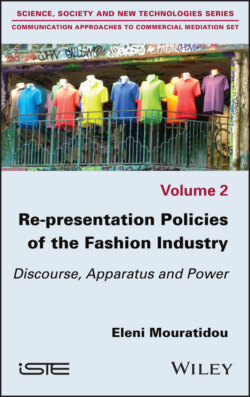Читать книгу Re-presentation Policies of the Fashion Industry - Eleni Mouratidou - Страница 9
I.2.1. Luxury fashion
ОглавлениеThis book therefore deals with the spectacularization of the fashion industry, a spectacularization that is both economic and symbolic. More precisely, the study proposed here focuses on so-called luxury fashion13, a segment chosen for two reasons that seem to me to be complementary: that of its economic influence and that of its communication strategies. Both – economy and communication – are subject to processes of spectacularization, whether it is a question of economic data or images of esthetics calculated down to the smallest detail.
Starting from the principle that spectacularization is the “process that makes spectacular not only any art, but also any other socio-semiotic field” (Tore 2011, author’s translation), it seems relevant to consider as spectacular both the economic performance of luxury fashion and its communication performance. In June 2019, the Bloomberg Billionnaires ranking introduced in third place Bernard Arnault, CEO of the luxury group LVMH, with a personal fortune estimated at 100.4 billion dollars. In the same ranking, we also noted the names of François Pinault, of the luxury group Kering, with a personal fortune of 37.1 billion dollars, as well as the Wertheimer brothers, owners among others of Chanel, whose personal fortune is estimated at 26.7 billion dollars14. These figures represent a spectacular performance, since they are extraordinary and attract a certain amount of media interest. By advertising them, the luxury fashion industry introduces into media the space information that unfolds the spectacular potential of its economy, a potential that is transformed into a particularly media-generated event. Just as the communication strategies of this same sector, whose aim goes beyond the promotional dimension and which mobilize the spectacle for political purposes: if the spectacle in its primary, archaic form has both a communicative and political dimension15, it is supposed to lead to a life form that relates to being together. It is to this end that luxury fashion seems to use the spectacle, in order to create something common and to position itself within a project with collective, political pretensions.
The commercial luxury fashion industry has developed a particularly dense potential for spectacularization, which could be described as mediagenic (Marion 1997, pp. 61–88). This potential for spectacularization is also linked to the close relationship that the industry in question has with art and in particular the contemporary art market, which is also highly spectacular. By “fostering closer ties between famous artists and branded objects treated as unique pieces of artisanal origin (for example, Hermès bags or Vuitton luggage)” (Boltanski and Esquerre 2017, p. 33, author’s translation), the luxury fashion industry is doubling its spectacular staging.
Entertainment shapes this industry, its goods, its actors and its discourse. Thus, this spectacular capacity aims to depict the fashion industry not so much as a creative industry with a commercial vocation, but, on the one hand, as a leisure industry, the spectacle being conceived here as a process of entertainment for the general public, and, on the other hand, as a media industry of “general interest” (Tremblay 2007, p. 216) and occupying in particular the public sphere, its “economic-social formation, its schedule” (Debord 1987, p. 13, author’s translation).
